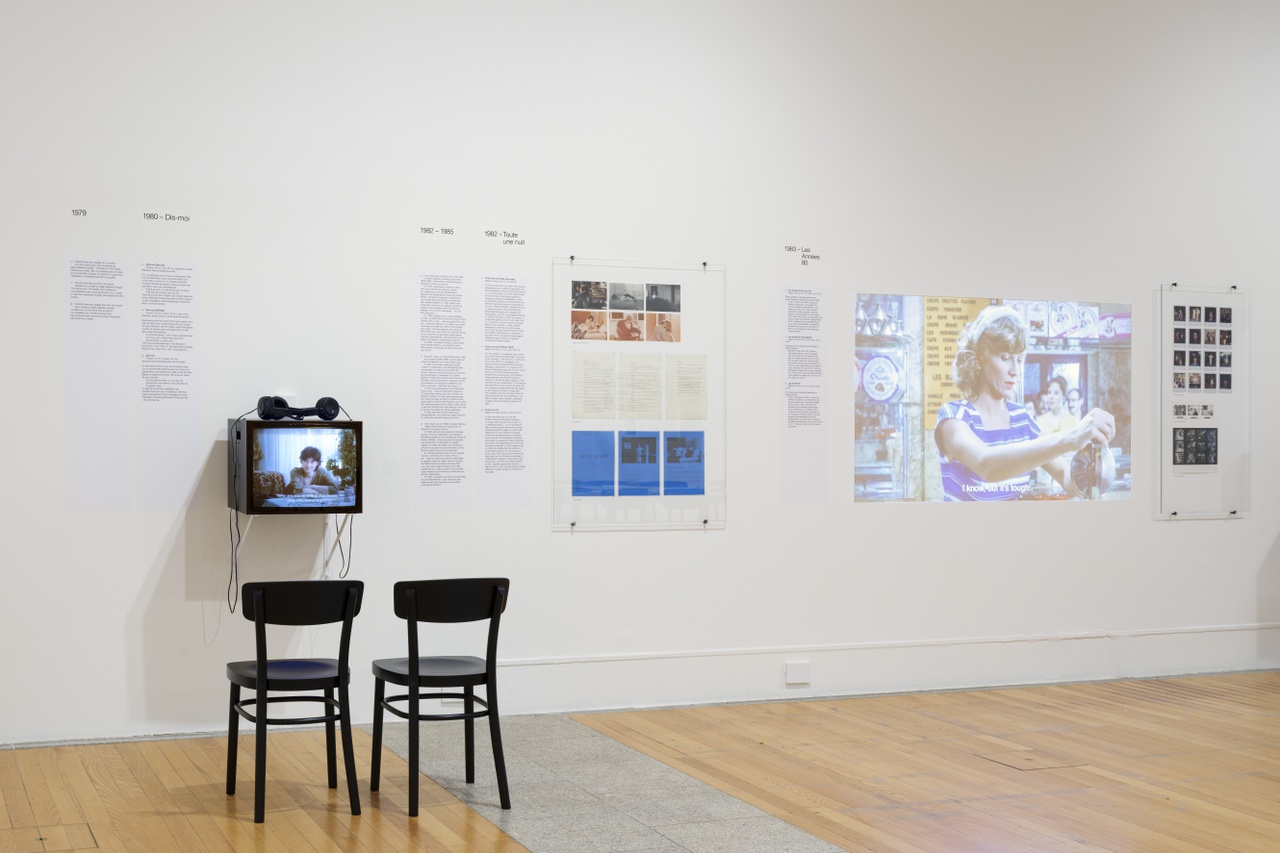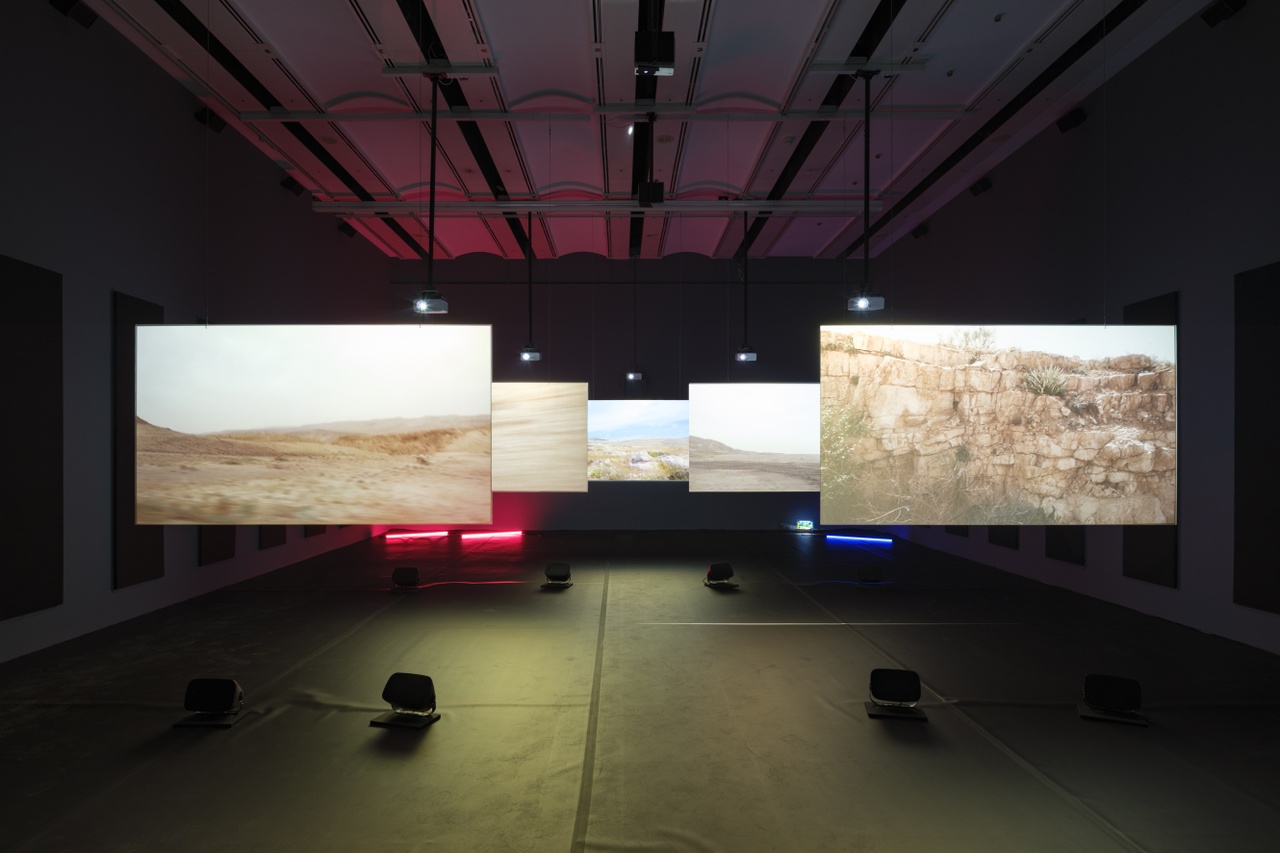MEMORY TRANSFERS IN AND BEYOND SILENCE Rainer Bellenbaum on Chantal Akerman at the Centro Cultural de Belém, Lisbon

Chantal Akerman, “D’Est,” 1993
Chantal Akerman’s installation From the Other Side (2002) [1] is the first work the artist conceived specifically for an exhibition, [2] and its third part, Une voix dans le desert, now occupies a large space in the artist’s retrospective “Chantal Akerman: Travelling” in Lisbon, curated by Laurence Rassel. According to Akerman, the idea for that installation preceded the accompanying film, De l’autre coté (2002), and it was only after the presentation of From the Other Side at “documenta 11” that she shot the film’s remaining parts. The change of perspective suggested in the title can thus be understood in at least two ways: not only in the sense of the two sides of the US–Mexican border, where attempts at migration are often brutally thwarted (as Akerman’s film documents), but also in relation to the two sides of her practice – that is, to the constant shift between documentary, fictional, or essayistic film dramaturgy on the one hand and allegorical artistic creation on the other. Moreover, changes in perspective define Akerman’s work as a whole and inform the artist’s most important concern: the representation of the lived experience of women, which this retrospective revolves around without explicitly focusing on it.
True to its title, the show travelled from Brussels to Paris before eventually arriving in Lisbon, and most of its larger-scale installations are similarly characterized by the mode of travel. Une voix dans le désert is a large film installation depicting a screen in the Arizona desert, onto which Akerman projected footage of highway traffic near the border and illegal border crossings detected by thermal cameras. These projections ran day and night but were temporarily rendered invisible by the bright sunlight. In the voiceover, which alternates between English and Spanish, the artist tells the story of a man who misses his mother. D’Est, au bord de la fiction (1995), which consists of 24 monitors positioned at the center of the exhibition, is based on footage from Akerman’s road movie D’Est (1993), which documents the artist’s travels through Eastern Europe. Arranged in four rows, each divided into two groups of three, these monitors invite visitors to stroll past the slow tracking shots of a wintry, nocturnal perestroika Moscow, close to bus stops and waiting members of the public. While they are visibly irritated by the camera filming them at such close range, these people remain calm for the most part; in the rare cases that someone does complain, they do so without interrupting the view of the slowly passing camera. The footage for Akerman’s last artistic work, Now (2015), [3] was produced during a trip across the United States, filmed with a handheld camera from the side window of a car. The installation premiered at the Venice Biennale in 2015, shortly before the artist’s suicide. In Lisbon, its five projections are distributed in a V-shaped arrangement in a darkened room. Desert and steppe landscapes fly by aimlessly, occasionally coming to a stop on one of the screens before plunging further, the horizons of the landscapes sometimes stable, at others tilting hectically. The images are accompanied by an audio collage made from wind noises and the soundtracks of earlier films by Akerman. In the background, the glow of two fluorescent tubes and two small fake aquariums illuminates the floor.

“Chantal Akerman: Travelling,” MAC/CBB, Lisbon, 2025
At first glance, the expansively arranged installations in the exhibition seem far removed from Akerman’s feminist concerns. Instead, it is the smaller works, some of which are installed in brighter rooms, that bear witness to this fundamental aspect of the artist’s work; for example, her dark, Chaplinesque debut film Saute ma ville (1968), presented here in the same room as the impressive short films she made to apply for the Institut Supérieur des Arts du Spectacle (INSAS) in Brussels. Or Woman Sitting After Killing (2001), a loop installation of the nearly six-minute static final scene from Akerman’s film Jeanne Dielman, 23, quai du Commerce, 1080 Bruxelles (1975), [4] in which the title character (a housewife, mother, and secret prostitute played by Delphine Seyrig) finally transgresses her meticulous sense of duty and order, murders a client, and then freezes in sober silence.
In fact, however, there is a close connection between Akerman’s travel-related projects and her more overtly feminist work. For the latter, the Brussels-born artist drew heavily on her mother’s biography, lifestyle, and stories, finding herself vacillating between closeness and detachment. She felt drawn to her mother but also had to distance herself emotionally from her. It was particularly challenging for Akerman that her Jewish mother – who was born in Tarnów in Austro-Hungary (now Poland), fled with her family to Belgium but was deported from there to Auschwitz-Birkenau – remained silent as a survivor, despite her daughter’s pleas for information about her life in the concentration camp. In Akerman’s words: “Because my mother never said anything about the camps, no doubt all my work came from that.” [5] Accordingly, authors such as Alisa Lebow [6] consider Akerman’s films in light of the discourse on transgenerational trauma and “postmemory” – a term coined by the literary scholar Marianne Hirsch to discuss how the descendants of individuals who have experienced extreme trauma, such as Holocaust survivors, “connect so deeply to the previous generation’s remembrances of the past that they identify that connection as a form of memory, and that, in certain extreme circumstances, memory can be transferred to those who were not actually there to live an event.” [7]
In addition to the aforementioned installation on Jeanne Dielman, there are some particularly noteworthy films that demonstrate Akerman’s attempts to connect with her mother’s unspoken memory. These films are documented in the exhibition’s archive room on wall tableaux consisting of texts, film stills, and sometimes video clip projections or 16 mm film strip material. In one, News from Home (1976), the director reads out letters she received from her mother during a stay in New York. Initially comprehensible, the emotionless voiceover is increasingly drowned out by the atmospheric sounds of the streets and subways of Manhattan. The mother’s words of longing and her daughter’s indifferent voice are dazzlingly interwoven, as are mundane scenes from everyday life and monumental cityscapes. The essayistic structure of the film allows an imagined echo of the mother’s inexpressible feelings to resonate in her daughter’s apathetic reading.

Chantal Akerman, “Now,” 2015
The film Les Rendez-vous d’Anna (1978) is documented with still photos and text that underscore Akerman’s highly ambivalent relationship with her mother. In this feature film, the fictional director Anna – a figure with whom Akerman explicitly identified, according to the accompanying text – is almost annoyed when her mother finds out her hotel address during her travels. On the other hand, the two encounter each other in a more intimate way than is the case in Anna’s rendezvous with a male friend and some romantic travel acquaintances. A special variation of connecting trans- or intergenerational memories – a kind of cinematic “memory transfer” [8] – is presented in the documentary TV feature Dis-moi (1980), which is included in the exhibition as a video excerpt, and for which Akerman visited three older women in Paris who were also formerly interned in Nazi concentration camps. Between their brief, sometimes talkative appearances and stories about their grandmothers, Akerman shows herself entering the women’s homes or listening to them, while her mother can be heard as a voiceover, talking about how, after returning from the camp and the deaths of her parents, she was lovingly cared for by her grandmother and so never felt like an orphan.
Unfortunately, the film in which Akerman drew the clearest connection between her loving yet complex relationship with her mother and her own nomadic tendencies is missing in this show: No Home Movie (2015), in which the dynamic desert images from Now are juxtaposed with her last documented attempts to communicate with her mother shortly before her mother’s death. This film convincingly expresses the emotional closeness and estrangement between Akerman and her mother, entirely in line with what the artist once said in an interview: “The real reason I live in Paris is quite unrelated to whether or not I like the city. In a way, I didn’t want to live at home, but I didn’t want to be too far away either.” [9] But even without No Home Movie, this retrospective deserves credit for highlighting Akerman’s installation work, and for instructively showcasing the many facets of this extraordinary artist.
“Chantal Akerman: Travelling,” Centro Cultural de Belém, Lisbon, April 17–September 7, 2025.
Rainer Bellenbaum lives in Berlin and works as an author, lecturer, and filmmaker.
Image credits: 1. courtesy Collections CINEMATEK, © Chantal Akerman - Fondation Chantal Akerman / VG Bild-Kunst, Bonn, 2025; 2.–3. courtesy MAC/CCB, © Chantal Akerman, photo António Jorge Silva / VG Bild-Kunst, Bonn, 2025
Notes
| [1] | Unlike the film De l’autre coté, the installation originally appeared under its English title. |
| [2] | Chantal Akerman, quoted in Chantal Akerman: Travelling, exh. cat., ed. Bozar-Centre for Fine Arts and Jeu de Paume (Lannoo, 2004), 178. |
| [3] | Conceived together with Akerman’s longtime editor Claire Atherton. |
| [4] | In a 2022 poll of critics conducted by the British Film Institute’s Sight and Sound magazine to determine the best film of all time, Jeanne Dielman took first place. |
| [5] | Akerman, quoted in Travelling, 164. |
| [6] | Alisa Lebov, “Memory Once Removed: Indirect Memory and Transitive Autobiography in Chantal Akerman’s D’Est,” Camera Obscura 18, no. 1 (2003): 47ff. |
| [7] | Marianne Hirsch, The Generation of Postmemory (Columbia University Press, 2012), 3. |
| [8] | Ibid. |
| [9] | Akerman, quoted in Travelling, 166. |

